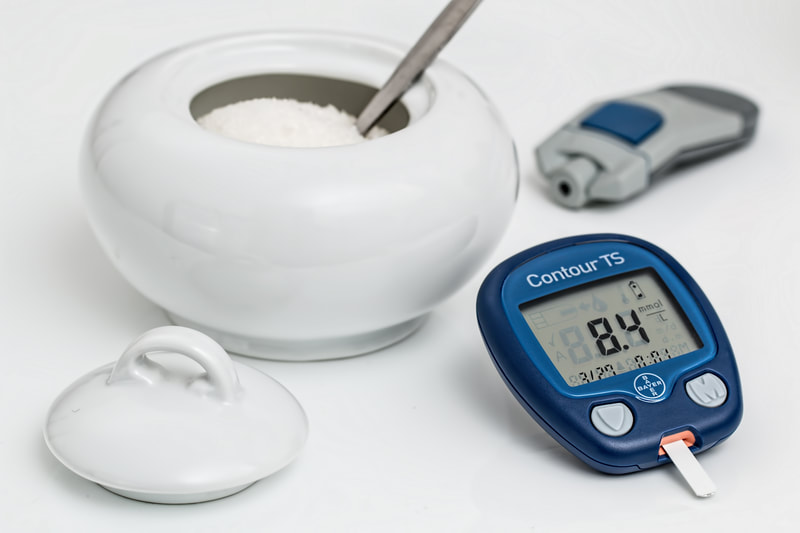You have a problem: you are told you have insulin resistance, pre-diabetes, or type 2 diabetes.
Take a slow, deep breath in and out. I know that this process of moving from shock to healing can feel overwhelming or frustrating. But maybe this diagnosis is an opportunity to turn the ship around. You can do this, because the good news is, insulin resistance is reversible. What’s more, it doesn’t have to be hard or complicated. Consistent, modest life-style changes can improve the cell’s sensitivity to insulin.
Here’s a short list of what’s in it for you when you improve your insulin sensitivity.
Now I invite you to join me on a knowledge adventure.
As your coach, I’ll share with you that I once had metabolic syndrome, the term for a cluster of common risk factors that always includes insulin resistance and two of the following:
1. High blood pressure (greater than 130/85 mmHg)
2. Excess fat around the waist
3. High triglyceride levels
4. Low levels of good cholesterol, or HDL
5. High blood sugar (insulin resistance)
If you have just one of these additional conditions, you are at risk for developing metabolic syndrome.
There’s a limit to what our bodies can handle. Rather than treating the symptoms of metabolic syndrome with drugs, the goal should be to fix the causes of insulin resistance.
Here’s why and how insulin resistance develops.
When you eat food with carbohydrates, your digestive system breaks them down into glucose, which is absorbed into the bloodstream for energy. To keep blood sugar levels in a normal range, the endocrine system uses insulin, a hormone produced in the pancreas.
Insulin becomes a problem when there is too much sugar in your bloodstream and as a result, insulin. Your body is working hard to do the right thing, but when insulin levels are chronically high, a resistance at the cell wall develops that prevents insulin from entering freely and doing its job.
Common lifestyle factors, such as lack of exercise with resultant muscle wasting, and other conditions such as inflammation and liver dysfunction, can worsen insulin resistance.
So how do you reverse it?
With small and consistent changes to what you eat, how you rest, move, and manage the stressors in your life, you can reverse insulin resistance, prediabetes, or type 2 diabetes by treating the causes of insulin resistance.
These are some of the lifestyle changes that when used in combination can reverse insulin resistance:
Knowledge alone is not enough however, which is where a health coach comes in. Change is hard! I am confident however that in time you will be deeply satisfied by the changes you choose to make. In addition, you will be able to sustain them, because strategies can be tailored to your tastes and needs.
Take a slow, deep breath in and out. I know that this process of moving from shock to healing can feel overwhelming or frustrating. But maybe this diagnosis is an opportunity to turn the ship around. You can do this, because the good news is, insulin resistance is reversible. What’s more, it doesn’t have to be hard or complicated. Consistent, modest life-style changes can improve the cell’s sensitivity to insulin.
Here’s a short list of what’s in it for you when you improve your insulin sensitivity.
- Have more energy, strength, peace, and confidence
- Eliminate food cravings
- Resolve digestive problems
- Sleep better
- Decrease anxiety, depressive symptoms, and feelings of hopelessness
- Stop the cascade of bodily dysfunction
- Take less medication (working closely with your healthcare provider)
Now I invite you to join me on a knowledge adventure.
As your coach, I’ll share with you that I once had metabolic syndrome, the term for a cluster of common risk factors that always includes insulin resistance and two of the following:
1. High blood pressure (greater than 130/85 mmHg)
2. Excess fat around the waist
3. High triglyceride levels
4. Low levels of good cholesterol, or HDL
5. High blood sugar (insulin resistance)
If you have just one of these additional conditions, you are at risk for developing metabolic syndrome.
There’s a limit to what our bodies can handle. Rather than treating the symptoms of metabolic syndrome with drugs, the goal should be to fix the causes of insulin resistance.
Here’s why and how insulin resistance develops.
When you eat food with carbohydrates, your digestive system breaks them down into glucose, which is absorbed into the bloodstream for energy. To keep blood sugar levels in a normal range, the endocrine system uses insulin, a hormone produced in the pancreas.
Insulin becomes a problem when there is too much sugar in your bloodstream and as a result, insulin. Your body is working hard to do the right thing, but when insulin levels are chronically high, a resistance at the cell wall develops that prevents insulin from entering freely and doing its job.
Common lifestyle factors, such as lack of exercise with resultant muscle wasting, and other conditions such as inflammation and liver dysfunction, can worsen insulin resistance.
So how do you reverse it?
With small and consistent changes to what you eat, how you rest, move, and manage the stressors in your life, you can reverse insulin resistance, prediabetes, or type 2 diabetes by treating the causes of insulin resistance.
These are some of the lifestyle changes that when used in combination can reverse insulin resistance:
- Eat more whole food and healthy fats, fewer carbs
- Increase muscle mass
- Prioritize sleep quality
- Manage stress
- Foster mindfulness
- Lose excess weight (which is a natural result of the above changes)
Knowledge alone is not enough however, which is where a health coach comes in. Change is hard! I am confident however that in time you will be deeply satisfied by the changes you choose to make. In addition, you will be able to sustain them, because strategies can be tailored to your tastes and needs.

 RSS Feed
RSS Feed